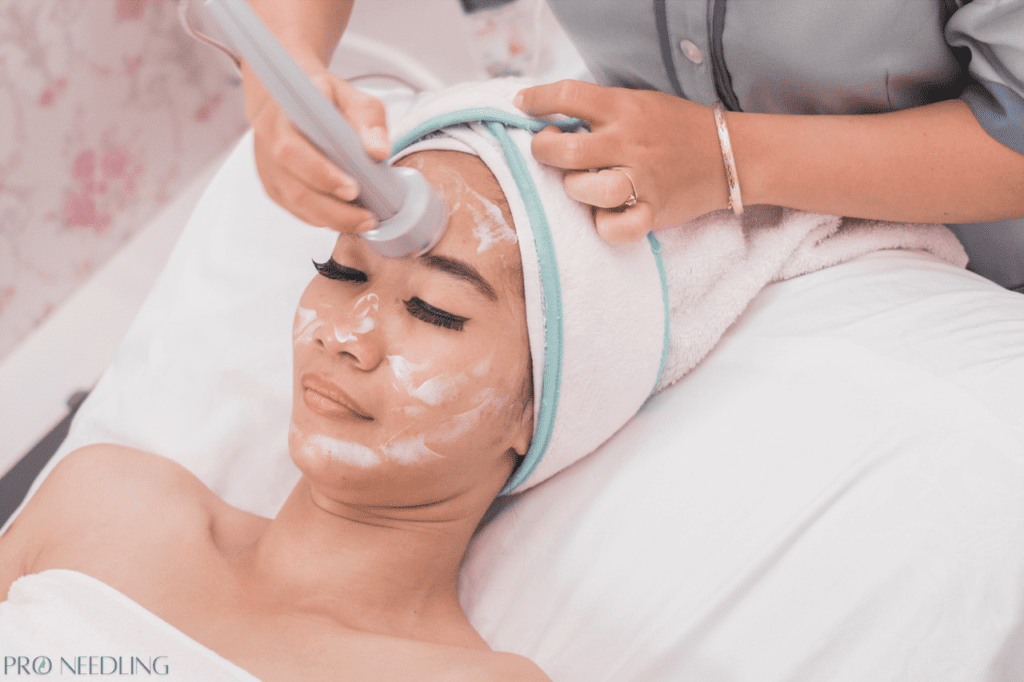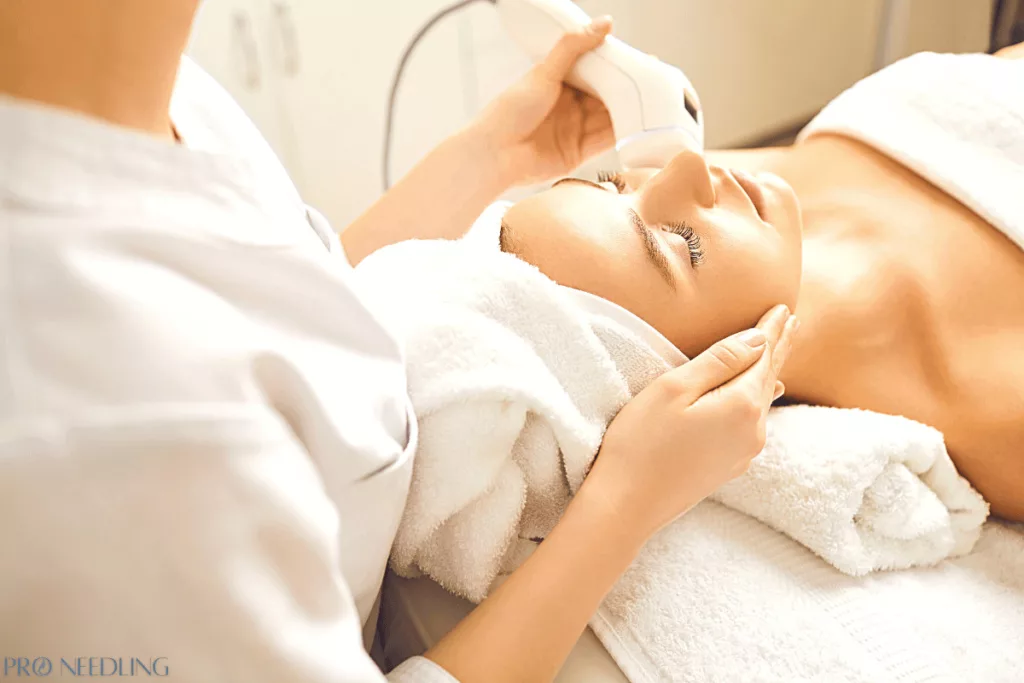Often referred to as the new and improved version of microneedling, Microchanneling is a non-invasive skin treatment procedure that uses a tapping or stamping technique to puncture the surface of the skin. This form of skin needling also improves the body’s natural collagen and elastin-producing capabilities and is used to enhance and rejuvenate the skin.
This form of microneedling uses a stamping device to administer the micro punctures and is generally administered under the supervision of a skincare professional. Micro channeling has become a popular treatment for those who are looking to treat stretch marks, acne scars, and other types of skin imperfections.
Table of Contents
- How Does Microchanneling Work?
- What Is Microchanneling Treatment?
- Microchanneling Benefits
- Who Is Microchanneling For?
- How Does Microchanneling Differ From Microneedling?
- How Long Can Microchanneling Take to Show Results?
- How Often Should You Do Microchanneling?
- Does Microchanneling Cause Pain?
- How Much Does Microchanneling Cost
How Does Microchanneling Work?
Microchanneling stimulates the outermost layers of skin to kick your body’s natural processes into action, increasing collagen production and communication level within the skin. The process improves scars by breaking down the older tissue, which causes the body to naturally lean towards producing newer and healthier skin within the area.
Creating tiny punctures in the skin’s surface allows for the penetration of skin products or serums that provide growth factors and other helpful building blocks associated with the skin. The body’s natural ability to heal itself combined with state-of-the-art growth serums helps perfectly heal the skin and diminish any future aging signs.

What Is Microchanneling Treatment?
First, a skincare professional will lightly stamp the target area to create the microchannels. This is to allow for the absorption of numbing cream to be applied and then will let sit for around 10-15 minutes. Next, a serum such as hyaluronic acid will be applied to a small zone of the skin.
Generally, a less sensitive area will be used first, such as the cheeks to allow the patient to test the feel of the process. After a serum is applied, the microchanneling device will be used with precision micro-needles to create microchannels by tapping into the skin uniformly.
With a single pass, these needles end up making a couple hundred thousand microchannels on the face, allowing the absorption of the rich nutrient serums. Serum application and the micro channeling process will be repeated over the desired areas, one small area at a time.
A professional will make sure to lightly stretch out the skin in order to make accurate tiny perforations. Make sure that the needles always stamp the skin and never drag. The device will be used to go over the area a few times, as there is no set standard number of times to pass over an area.
Generally, a good sign that the area is completed is when the skin turns pink, showing that there is an inflammatory response. In thinner-skinned areas, like around the eyes, a gentle touch with the device will do.
The healthy tissues within the skin initiate a healing response as soon as the microchannels are made. Every micro-channel or, in better words, every micro-injury, results in an inflammatory healing process to cover up the damage. This stimulates the production of new collagen and elastin, responsible for the strength and resilience of the skin.
With time, the continuous production of collagen due to the repeated healing process creates a better overall appearance and younger-looking skin.
Microchanneling Benefits
The benefit of microchanneling is the advantage of treating small areas with greater control. Specifically, hard-to-treat areas like under the eyes or around the mouth. Since the needle speed and depth can be adjusted, multiple skin conditions can be treated with one device.
Who Is Microchanneling For?
Microchanneling is suitable for people of all skin types and ages and can be used to treat skin anywhere on the body.
Even if you’re prone to chronic breakouts, microchanneling is a relatively safe procedure and does not result in lasting side effects such as scarring or hyperpigmentation. Microchanneling treatment can work wonders if used for:
- Fine lines and wrinkles
- Acne scars
- Stretch marks
- Hyperpigmentation, sun damage, or uneven skin tone
- Skin tightening and anti-aging
- Hair Growth
- Reduction of pore size
How Does Microchanneling Differ From Microneedling?
The main difference between microchanneling and microneedling is the technique and the devices used to perform the treatments. The purpose and benefit are generally the same, as both treatments use needles to trigger the body’s natural healing process to stimulate skin cell renewal and healthy skin.
Microneedling can be performed with three handheld devices: a dermaroller, microneedling pen, or a dermastamp. All of these devices contain needles, but the way in which they directly enter the skin can be different.

A dermaroller “rolls” the needles over the surface of the skin. This device comes with a risk of tearing the skin, as the rolling motion of needle penetration can cause damage by ripping the skin.
Micro needling pens are automated and penetrate the skin perpendicularly and with great accuracy. They need to be administered correctly by a skincare professional to control the speed and depth. The pen glides over the surface of the skin, almost like receiving a tattoo.
A derma stamp also penetrates the skin perpendicularly in a stamping motion. Stamps are great for small areas like around the nose and mouth, where derma rollers may be too large to treat.
A Microchanneling pen is a powered stamping device that uses an electrical source or batteries. This device utilizes a linear stamping technique that forms uniform microchannels. Think of a microchanneling device as an automated or electric derma stamp.
Compared to dermarolling, the production of such consistent and clean channels causes less tissue damage, inflammation, and discomfort for the client undergoing treatment. The reduction in inflammation also means that microchanneling has a smaller downtime (around 60-90 minutes) than microneedling (which can take days).
How Long Can Microchanneling Take to Show Results?
The production of new collagen after the process can take a few weeks to months depending on each individual healing and immune system. However, it is not unheard of to see a noticeable improvement in skin texture and quality after just the first day.
How Often Should You Do Microchanneling?
To gain the most out of microchanneling, it’s recommended to schedule an appointment every 4-6 weeks to keep the production of elastin and collagen consistent and the results more noticeable. The best answer is to continue treatment as needed, as treatment
Does Microchanneling Cause Pain?
Microchanneling is a non-invasive technique. This, of course, does not mean that the needles do not penetrate your skin. Most people who undergo the process don’t feel any noticeable pain even without numbing cream. At most, an individual will feel minimal physical discomfort.
While there is no lingering discomfort after treatment, it can result in skin irritation or dry skin which can be solved by putting moisturizer or any additional product after a 90-minute wait. Most people only report feeling their skin “tighten” after the procedure.
How Much Does Microchanneling Cost
The microchanneling cost will vary on location, the provider, the size of the treatment area, and the condition being treated.
